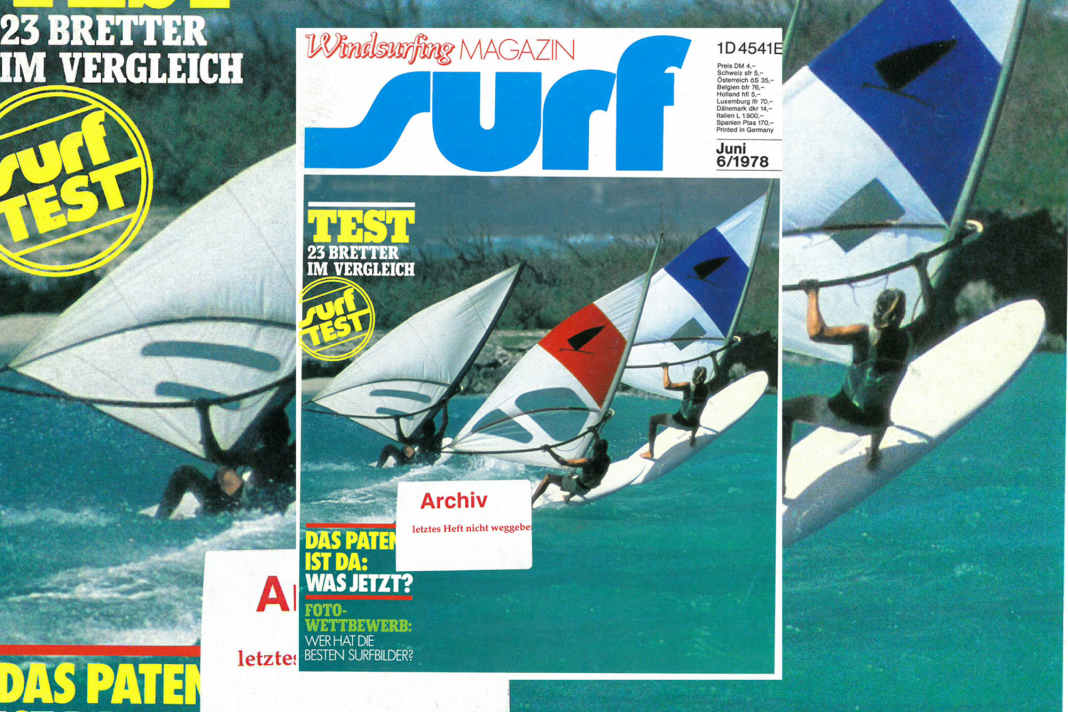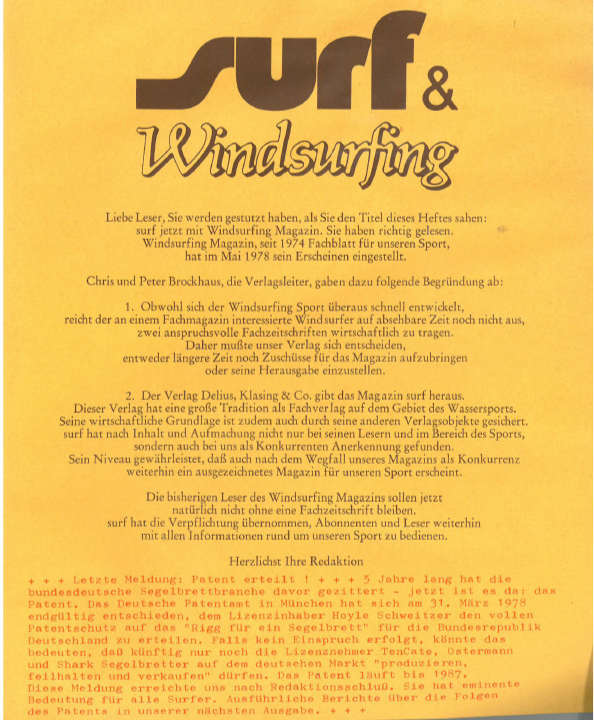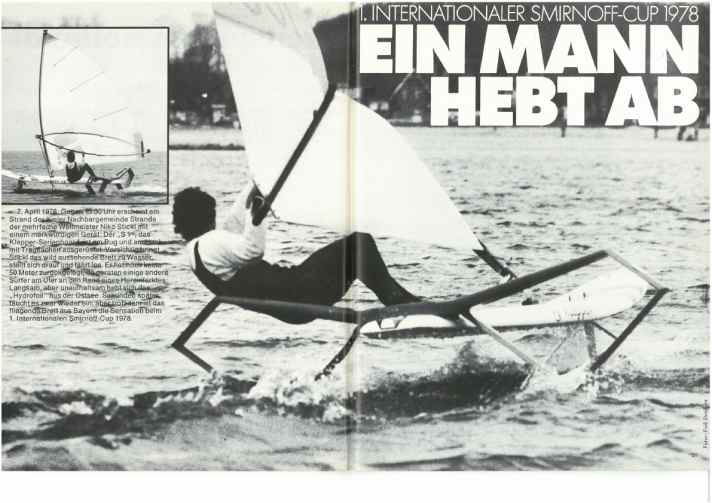





The June 1978 issue of surf - just under a year after the very first issue - is the first issue after two significant events. We have to take a step back and take a look at the May issue that appeared before. At that time, surf and the magazine "Windsurfing" were merged, and the old lettering was to remain on the cover for some time afterwards. Peter and Chris Brockhaus, the founders of "Windsurfing", wrote in an insert in May 1978 that two magazines would not be profitable on the German market and they therefore referred readers and subscribers to surf: "Its standard ensures that an excellent magazine for our sport will continue to be published even after our magazine ceases to exist as a competitor!"
The second event was only hacked onto the above-mentioned bound-in insert in the May issue at the last minute by typewriter: "Last message: Patent granted! [...] On 31 March 1978, the German Patent Office in Munich finally decided to grant the licence holder Hoyle Schweitzer full patent protection for the 'rig for a sailing board' for the Federal Republic of Germany!" As announced, a more detailed look will follow in the June issue.

The infamous patent
surf feared correctly: the patent for Hoyle Schweitzer led to an avalanche of litigation in the following years (in the Issue 5/1982 four trials are reported) and made the range of boards available much smaller. This applies neither to the mast foot joint nor to the forked boom, but to the concept of the "unstayed" rig, which is only held with the hands. The competition is looking for loopholes, and one variant would be a newly invented replacement for the boom, which could be used to circumvent the patent. However, individual windsurfers are not affected, regardless of what kind of board they use privately. However, anyone who buys a board abroad and brings it to Germany is, strictly speaking, liable to prosecution. On the back of the magazine, TenCate - one of the few companies with a licence - also advertises: "Watch out for the trademark!"
However, the rest of the industry is still reacting relatively calmly and has announced in a survey that it will either pay licence fees or join forces to defend itself against the patent. Others are sounding out the possibility of direct sales from abroad or sales from depots across the border. Even if the patent only applies to Germany, the decision will not leave the brands unscathed, as Germany accounts for around 40% of the global market. In a commentary, surf founder Ulrich Stanciu appeals to Hoyle Schweitzer to deal openly with the patent and to value the development work of numerous smaller companies. However: Of the brands mentioned and those in the test (see below), most of them had already disappeared a few years later.
Foils and wings on the Kiel Fjord
Today a familiar sight, in 1978 "some other surfers are on the verge of a heart attack": the fastest windsurfer is sought at the Smirnoff Cup off Schilksee and receives a considerable 3000 marks in prize money. As there is no need to tack or go upwind, some participants compete with adventurous constructions. Niko Stickl builds one of the first foiling boards, Clive Colenso goes for a swim with a kind of spinnaker that is vaguely reminiscent of today's wings. Others compete with mini catamarans or try to get a water ski off the board at full speed. Spectacular vehicles, but in the end conventional constructions prove to be the fastest.

Lots of breakage during the surf test
surf picked 23 boards out of 66 new products of the year, which were tested in a large-scale comparison on the Baltic Sea off Schilksee for 14 days. This was to be the last major test of this kind for the time being, as the patent significantly restricted the scope for the following years. In the spring of 1978, many details that were not fully developed caught the eye: "Folding centreboards that did not fold, booms that ran full of water due to a lack of foam and wooden centreboards that lacked not only the last but also the first sanding" were criticised. Some of the planks were full of water, elsewhere fins, masts and daggerboards broke. An important criterion at the time was how much pull would release the base plate from the board, and could this release force be adjusted? From today's perspective, this is striking (and even then it was an exotic feature): The "Solar Star" with a fixed - but crooked - keel. Other boards are partially hollow for weight reasons.
You can click through the entire magazine in the gallery above!
And what else?
- Due to the "difficult handling and extreme tendency to capsize", the Düsseldorf district president declares surfboards a risk factor and bans surfing on Lake Baldeney and the Kettwig reservoir at weekends and on public holidays; on weekdays, a licence costs DM 5. A local club protested and the authorities presented a "compromise": the ban would not apply between 15 November and 15 March - in the middle of winter. The club announces further protests.
- The "German Windglider Tandem Class Association" has defined the key data for the class: The board must be at least 65 centimetres wide, a maximum of 6.80 metres long and weigh at least (!) 48 kilos.
- The suffering of the boom: A reader gives a tip to make slippery aluminium forks more grippy with a bicycle inner tube
- Another reader mail: Georgi Batari writes from Tallinn (now Estonia) and reports on the windsurfing scene behind the Iron Curtain: "There were only 36 participants at the first championship in Minsk in 1975. At the five regattas for the USSR Cup last year in Nida, Riga, Minsk, Moscow and Leningrad, over 100 people took part in each!" Somehow surf also seems to have made it to the former Soviet Union: "After reading surf, we realise that we will have the same problems and joys when we appear on the global scene."
- surf announces Robby Naish's first trip to Europe: "After Robby has already been confronted with some native Bavarians from Barracuda and Hawaii and Jamaica, his interest in our country is particularly great." Naish wants to ski and give courses at Lake Garda, Lake Walchensee and Lake Constance.
- Photo pros give tips for good surfing pictures. A reminder for the younger ones: Back then, photos were still taken on film and only developed after the holiday...
- Sylt local Calle Schmidt wrote a spot guide to his home island for surf. It ends with a call to break the then record for a trip from Munkmarsch to Blidselbucht: 33 minutes
- "Charlys Windsurfing Service" offers a shuttle from Munich to Lake Garda. It leaves early in the morning on Saturdays and costs 60 marks.
More surf reviews:
- These were the highlights in surf 4/1979
- These were the highlights in surf 4/1981
- These were the highlights in surf 5/1982
- These were the highlights in surf 9/1984
- These were the highlights in surf 8/1985
- These were the highlights in surf 8/1986
- These were the highlights in surf 8/1988
- These were the highlights in surf 4/1990
- These were the highlights in surf 6/1991
- These were the highlights in surf 3/1992
- These were the highlights in surf 9/1993
- These were the highlights in surf 4/1994
- These were the highlights in surf 11-12/1996
- These were the highlights in surf 7/1997
